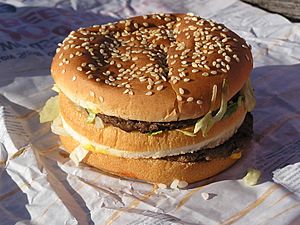Big Mac Index facts for kids
The Big Mac Index is a fun way to compare how much things cost in different countries. It's an economic index that uses the price of a McDonald's Big Mac burger. By looking at how much a Big Mac costs in different places, we can see if one country's money is stronger or weaker than another's.
This idea was first shared by The Economist magazine in September 1986. They still publish it every year! The Big Mac was chosen because it's made almost the same way everywhere. This makes it a good item to compare prices around the world.
Contents
How the Big Mac Index Works
The Big Mac Index helps us understand exchange rates. An exchange rate tells you how much one country's money is worth compared to another's. For example, how many US dollars you need to buy one British pound.
Comparing Currencies
The index works by comparing the price of a Big Mac in two different countries.
- First, you find the price of a Big Mac in one country, using its own money.
- Then, you find the price of a Big Mac in another country, using its money.
- You divide the price of the Big Mac in the first country by the price in the second country. This gives you an "implied" exchange rate.
- Finally, you compare this "implied" rate to the real exchange rate.
What "Overvalued" and "Undervalued" Mean
If the "implied" rate is lower than the real exchange rate, it means the first country's money is "undervalued." This suggests that things are cheaper there compared to the second country. If the "implied" rate is higher, the money is "overvalued," meaning things are more expensive.
An Example from 2008
Let's look at an example from July 2008 to understand this better:
- A Big Mac cost $3.57 in the United States.
- A Big Mac cost £2.29 in the United Kingdom (Britain).
- If you changed the British price to US dollars using the real exchange rate at the time, the Big Mac in Britain would cost $4.57.
- The "implied" exchange rate was 1.56. This means that for every £1, you should get $1.56 if Big Macs cost the same everywhere.
- But the real exchange rate was $2.00 for every £1.
- Since the real rate ($2.00) was higher than the implied rate ($1.56), it meant the British pound was "overvalued" by 28% compared to the US dollar. This means things were relatively more expensive in Britain.
Related pages
Images for kids
See also
 In Spanish: Índice Big Mac para niños
In Spanish: Índice Big Mac para niños




